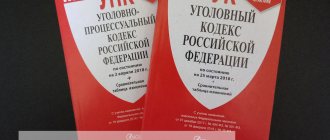MIP online legal encyclopedia - » Criminal cases - comments from a Federal Judge / MIP Law Group » List of articles on crimes » Intentional infliction of moderate harm to health - comments from a Federal Judge / MIP Law Group
Sign up for a consultation with the head of the criminal department. We specialize in Article 112 of the Criminal Code of the Russian Federation. Professional explanations. Unlimited consultation time
Intentional infliction of moderate harm to health - free answers from lawyers online
What is causing slight harm to health by negligence?
Infliction of slight harm by negligence - injuries received without any intent and which are not life-threatening, but cause long-term health problems or significant loss of ability to work. Careless infliction of average harm to health is regulated by Article 112 of the Criminal Code of the Russian Federation.
Signs and medical criteria
Infliction of average harm to health includes any act that was classified as unintentional and had signs of average harm to health. Medical signs of such an act include:
- The victim's life is not in danger.
- Serious and long-term health problems (hospitalization of three weeks or more).
Important! Sometimes the length of stay in a medical institution depends on the availability of prophylaxis and additional examination at the request of the client. In such a situation, the time spent on such measures is not taken into account. - Absence of such consequences: loss of limbs, more than 30% disability, fetus if the victim was carrying a child, irreparable facial disfigurement, psychological health problems.
Read more in our materials:
- Criteria for average health harm.
- Signs of moderate harm to health.
We also talked about health criteria here, and about mental health criteria here.
Intentional infliction of moderate harm to health (analysis of components)
Harm caused to health, which is not yet classified as particularly grave harm, but is no longer in a mild form, that is, so to speak, of moderate severity, can be caused not intentionally, simply through negligence or intentionally.
The criminal acts of the attacker, which resulted in a deterioration in the state of health of moderate severity, include: - beating in various forms of a person, which brought him physical pain and mental, moral suffering and distress.
This also includes torture that causes a person both painful physical and moral mental suffering. Torture of the victim occurs through various violent actions.
This includes both deliberate beatings of a person and holding him in the cold or other conditions that are harmful to health and fraught with consequences, deprivation of food, water, and the like.
Also actions on the part of the attacker with the intention of repeatedly causing pain with blunt or piercing objects, causing thermal burns, and the like.
The subjective side of such an unlawful act is the direct intent to cause pain and suffering to the victim.
The composition of criminal acts that qualify as intentional infliction of moderate harm to health includes objects that take part in a committed illegal action aimed at worsening the general physical condition of a person:
- relatives, in agony, in anger, causing physical harm to loved ones (domestic fights);
- acquaintances and friends, as a result of communication between whom hostile relations may arise over differences in views on politics, religion or other judgments;
- complete strangers, for the sake of hooligan fun, causing harm to strangers.
The crime, which the legislator qualifies as intentional harm of moderate severity to health, includes its subjective and objective sides.
The objective side of the crime can be characterized by negative and positive signs of harm to health. The negative side is that harm caused intentionally ultimately cannot be the cause of death, and does not entail more serious consequences for the health of the victim.
The positive side includes: the ability to work and care for oneself, lost up to the third part, and a fairly long recovery of health. The subjective side characterizing the composition of intentional injury and injury is that physical or mental pain and suffering are inflicted by direct or indirect intent, planned in advance.
The difference between an unintentional act and a careless one
By unintentional we mean by negligence; these are synonymous words.
Accordingly, unintentional injury to health is damage received without direct or indirect intent. This type of damage is not life threatening.
However, they cause long-term health problems (more than 21 days of treatment) or significant loss of ability to work (up to 30%).
How to confirm the absence of intent in an act?
We need to start collecting evidence as quickly as possible. Evidence will be:
- Video recordings that clearly show the lack of intent from CCTV cameras and recorders.
Note! Since in an accident there are most often no witnesses (or they do not want to testify), or the victim testifies against you, the video recording is the only thing that can help you prove your innocence. - Witnesses who can testify that the act was committed without intent.
- Other evidence that will depend on the specific case.
Having completed the collection of evidence, it must be immediately provided to the investigator. If the evidence really confirms that what was done was completely unintentional, your innocence is recognized and the maximum that can threaten you is financial and moral damage.
We wrote above that unintentional harm to health is equivalent to injuries that were received through negligence; accordingly, the procedure for refuting one’s guilt will be absolutely identical.
Why does this need to be proven?
Since causing moderate harm through negligence is not punishable by the Criminal Code of the Russian Federation, some are mistaken that nothing will happen to them and are in no hurry to prove the absence of intent. But after thinking a little, it is easy to understand that if you do nothing, it is almost impossible to avoid problems.
The main argument is prosecution under Article 112 of the Criminal Code of the Russian Federation. Intentional infliction of average harm to health can already threaten with restriction or imprisonment; things will be even worse if qualifying signs are identified, or the perpetrator of the crime has a criminal record.
Responsibility
As was described a little earlier, causing moderate bodily harm is not prosecuted by the Criminal Code of the Russian Federation. Depending on the specific situation, the culprit will have to answer under the Civil Code of the Russian Federation, for example, paying a fine in case of an accident. The victim also has every right to sue for compensation for financial and moral damage to health.
But sometimes a person, having found himself in such a situation by coincidence, does not have the opportunity to prove that the average harm was caused by negligence. Therefore, let's look at what threatens him in this case. Punishment will be applied in accordance with Article 112 of the Criminal Code of the Russian Federation, namely intentional infliction of harm of moderate severity, the crime is punishable from the age of fourteen. The perpetrator faces imprisonment from one to three years, correctional labor for up to 3 years, or arrest for up to six months.
Penalties for causing harm through negligence are applied as an additional punishment. As a matter of principle, they can often be applied in relation to Article 118 of the Criminal Code of the Russian Federation. It states serious bodily injury.
There is one exception: if we are talking about damage received as a result of an accident, then punishment may follow: a fine of 10 to 25 thousand rubles or deprivation of rights for a period of one and a half to two years. This is regulated by Article 12.24 of the Code of Administrative Offenses of the Russian Federation.
More often than not, it doesn't end up in prison. Exceptions may be situations where there are serious qualifying criteria, or the perpetrator already has a criminal record.
Reference: qualifying features are a number of reasons why a criminal may aggravate his sentence.
There are the following qualifying criteria:
- an atrocity due to which more than 2 people were injured;
- assault while performing official duties;
- if the victim was a minor and could not defend herself;
- a crime that was committed by force or humiliation;
- a criminal group consisting of several people;
- crime committed due to ordinary hooliganism;
- the villain who used the weapon;
- discrimination against religion or race.
In other cases, you face a suspended sentence or arrest.
The concept of moderate harm to health
There are three degrees to which harm can be caused to a person and his health:
- light;
- moderate severity
- severe form.
The legislator specifically defined types of damage to the human body, which he classified as grave. At the same time, the average form of damage to health is described in general terms.
It is assumed that in cases where a victim as a result of criminal acts receives a long-term disorder of body functions or in cases where a person’s ability to work is reduced by less than a third, this can be qualified as harm to the health of the victim of moderate severity.
Only a special forensic medical examination has the right to make a conclusion about the state of health. Law enforcement agencies, based on the conclusions made by doctors, are already classifying a criminal act and initiating a criminal case.
Thus, the concept of average severity of harm to health should be understood as follows:
- impairment of body functions not specified in the list defining severe harm;
- harm, in which the overall ability to work is lost by less than one third compared to the ability to work before the criminal act was committed against the victim, but more than causing slight harm to the body;
- health impairment as a result of unlawful acts against a person is long-lasting. The Criminal Code of the Russian Federation takes into account the type of harm caused to health when the vital activity of a person’s normal way of life is disrupted, although not significantly, which does not allow him to work as usual, although it does not have a fatal outcome.
The problem of distinguishing from other elements of crime
In this case, the main problem is to distinguish between intentional infliction of harm and unintentional infliction of bodily harm. This is decided by the provision of evidence from the applicant and the accused.
Also, differentiation from other elements of a crime can be made in such a way as differentiation by identifying similar and dissimilar features:
- Absence of common signs of the subjective side, object, objective side.
But the presence of such applies to the subject, a person who has reached the age of 14 or 16 years. An elementary example: let’s compare two articles 113 of the Criminal Code of the Russian Federation (causing seriousness in an affective state) and 158 of the Criminal Code of the Russian Federation (theft). It is precisely this criterion, the subject, that coincides here. In most cases, such distinctions do not occur. - Maximum similarity with minimal differences.
There are two articles: 111 and 112 of the Criminal Code of the Russian Federation. The first deals with causing grievous bodily harm, the second with moderate harm. Everything coincides, but there is a difference based on which the distinction is made - this is the degree of severity. Such cases are usually called related; sometimes the distinction can be difficult, since the Criminal Code of the Russian Federation contains many related crimes. - Minimal similarity.
Let's compare Article 118 of the Criminal Code of the Russian Federation (severe harm to health due to negligence) and Article 113 of the Criminal Code of the Russian Federation (moderate harm to health in a state of passion). This minimal similarity lies in the name - harm to health. But the distinctive features are quite an impressive list: the degree of damage, intentional infliction of injuries and in a state of passion, etc. It will not be difficult to distinguish it from other elements of crime.
Examples
Case 1. At a public event there were a lot of people trying to get through, but since it was quite difficult, they just started pushing. Krasnov K.L miscalculated the force and pushed the woman so hard that she fell. As a result of a medical examination, she was diagnosed with a concussion and several small bruises.
All this was classified as moderate damage. Most likely Krasnova K.L. will be obligated to compensate 100% for moral and physical damage; such an act will most likely not be prosecuted, since the absence of intent can be proven by the presence of a large number of witnesses and video cameras on the site where everything happened.
Case 2. Vostrikova K.L. Having not calculated the speed limit of her car, she got into an accident. She was not injured, but the other participant was injured. During the examination (more about ITU here) it was determined that he broke his leg and dislocated his arm.
It is very important here to prove the absence of any intent, but there are no witnesses and no video recorder. If somehow it is possible to refute her guilt, then Vostrikova faces a fine of 10 to 25 thousand rubles. If not, then she will have to answer under the Criminal Code of the Russian Federation. She may face arrest, probation, etc.
Case 3. P. G. Markov is a factory employee. The equipment used for production has broken down. In an attempt to fix it, he asked his partner to help by holding part of the machine. He accidentally turned it on, causing his hand to become jammed and require three fingers to be amputated.
If the victim decides to testify against Markov, he may face charges of intentional infliction of harm. If the partner confirms that everything really happened due to negligence, then the Criminal Code of the Russian Federation will not prosecute this.
Judicial practice: sentences and punishment under Art. 112 of the Criminal Code of the Russian Federation
- Resolution of the Plenum of the Supreme Court of the Russian Federation dated... PLENARY OF THE SUPREME COURT OF THE RUSSIAN FEDERATION DECISION dated December 27, 2002 N 29 ON JUDICIAL PRACTICE IN CASES OF THEFT,...
- Decision of the Supreme Court: Determination N 203-APU17-21... THE SUPREME COURT OF THE RUSSIAN FEDERATION Case No. 203-APU17-21 APPEAL DECISION Moscow August 31, 2022 Judicial Collegium for Military Personnel of the Supreme...
- Decision of the Supreme Court: Resolution No. 310P13 dated... DECISION OF THE PRESIDIUM OF THE SUPREME COURT OF THE RUSSIAN FEDERATION Case No. 310-P13 Moscow January 23, 2014 Presidium of the Supreme Court of the Russian Federation...
- Ruling of the ECtHR dated 02/14/2017 EUROPEAN COURT OF HUMAN RIGHTS THIRD SECTION CASE “MASLOVA VS. RUSSIAN FEDERATION” (Complaint No. 15980/12) JUDGMENT…
- Judicial Collegium for Criminal Cases, appeal:... THE SUPREME COURT OF THE RUSSIAN FEDERATION Case No. 72-APU 17-21 APPEAL DECISION Moscow October 04, 2022 Judicial Collegium for Criminal Cases...
- Resolution of the Plenum of the Supreme Court of the Russian Federation dated... PLENARY OF THE SUPREME COURT OF THE RUSSIAN FEDERATION DECISION of November 15, 2016 N 48 ON THE PRACTICE OF APPLICATION BY COURTS OF LEGISLATION GOVERNING FEATURES...
- Resolution of the Presidium of the Supreme Court of the Russian Federation dated... PRESIDIUM OF THE SUPREME COURT OF THE RUSSIAN FEDERATION DECISION dated December 5, 2018 N 126-P18 ON RESUMING PROCEEDINGS IN THE CASE DUE TO NEW...
- Resolution of the Plenum of the Supreme Court of the Russian Federation dated... PLENAUM OF THE SUPREME COURT OF THE RUSSIAN FEDERATION DECISION dated June 25, 2022 N 18 ON JUDICIAL PRACTICE IN CASES OF CRIMES,...
- Resolution of the Plenum of the Supreme Court of the Russian Federation dated... PLENAUM OF THE SUPREME COURT OF THE RUSSIAN FEDERATION DECISION dated December 17, 2022 N 43 ON SOME ISSUES OF JUDICIAL PRACTICE IN CASES...
- Decision of the Supreme Court: Determination No. 38-АПУ17-2 dated... THE SUPREME COURT OF THE RUSSIAN FEDERATION No. 38-АПУ17-2 APPEAL DECISION Moscow March 1, 2022 Judicial Collegium for Criminal Cases of the Supreme Court...






